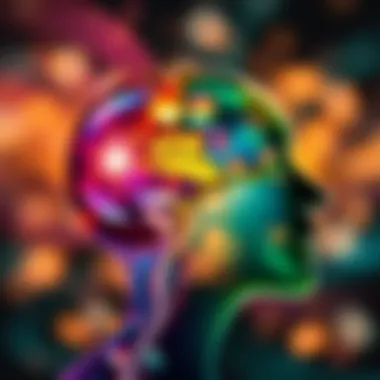Exploring Literature on Seduction: A Comprehensive Guide


Intro
The world of seduction has long fascinated both writers and readers alike. Its many layers interweave psychological strategies, cultural contexts, and timeless themes that can both challenge and enhance human interaction. As we navigate through the available literature, it becomes clear that seduction isn’t just about romantic encounters; it’s a holistic understanding of influencing and connecting with others. Through this journey in literature, several categories emerge that provide profound insights for those willing to delve deeply.
Categories of Life-Changing Books
Self-Help and Personal Development
In the realm of self-help literature, books focusing on seduction often emphasize personal growth and understanding individual insecurities. The cornerstone of effective seduction lies not just in the tactics employed but in the self-awareness cultivated during the process.
Notable Works:
- The Art of Seduction by Robert Greene – This classic outlines various archetypes in the seduction game and provides a strategic overview that blends psychology with history.
- The Game by Neil Strauss – This memoir-style narrative gives insights into the transformation of everyday individuals into confident seducers, making it a compelling read for anyone interested in the mechanics of attraction.
The techniques discussed often parallel larger themes of self-improvement. Understanding one’s strengths and weaknesses fosters a foundation that not only enhances seductive abilities but also promotes personal development and confidence in various aspects of life.
Fiction with Transformative Themes
Fiction can serve as a mirror for exploring the dynamics of seduction in human relationships. Novels that weave together stories of love, power, and desire often captivate readers and offer deeper meanings behind the act of seduction.
Some exemplary titles to consider include:
- Lolita by Vladimir Nabokov – A controversial take that examines obsession through the lens of seduction and manipulation, revealing the darker sides of attraction.
- Pride and Prejudice by Jane Austen – This beloved classic echoes the subtleties of social behavior and attraction during the Regency era, showcasing that seduction often is as much about social context as personal effort.
Fiction enables readers to experience seduction from different vantage points, providing deeper insights into emotional landscapes. As we engage with the characters’ journeys, we can reflect on our own perceptions about attraction and influence.
Book Summaries and Insights
Key Takeaways from Popular Titles
When exploring the literature on seduction, it is essential to extract the key insights that offer practical applications.
- Understanding Human Nature: Both Greene and Strauss emphasize the necessity of knowing the other person’s desires and fears. The more we understand others, the more effectively we can engage.
- Authenticity Over Manipulation: The best practices in seduction aim for genuine connection rather than disingenuous tactics. This approach yields deeper and more meaningful relational outcomes.
- Cultural Context Matters: Recognizing that seductive strategies vary greatly across cultures highlights the importance of adapting techniques to fit specific social or personal dynamics.
How to Apply Insights in Daily Life
While the literature can be comprehensive, putting the insights into practice is where the magic truly happens. Here are a few ways to integrate these lessons:
- Reflect on Personal Experiences: Take time to analyze past encounters and relationships. What tactics worked? What didn’t? Learning from personal history can guide future interactions.
- Practice Active Listening: Building genuine connections hinges on attentively understanding others' cues. By prioritizing listening over talking, one can better gauge what the other person truly wants.
- Engage Socially with Purpose: Going into social situations with a clear understanding of one’s intentions can support authentic interactions. The aim should not just be seduction but substantial engagement.
In summary, exploring literature on seduction unlocks a treasure trove of insights that extend far beyond simple tricks. It encourages deep reflection on interpersonal dynamics and personal growth.
To further enrich your understanding of seduction literature, consider checking out resources like Wikipedia and Britannica for comprehensive articles on key figures and concepts in seduction. Online forums like Reddit can also offer community insights and discussion points.
This guide aims to serve as a launching pad into the multifaceted world of seduction literature. Whether you're a student, a professional, or an avid reader, there's always something captivating to discover!
Understanding Seduction
Seduction is a complex and multifaceted topic that extends beyond the surface of mere attraction. It often intertwines with personal psychology, societal norms, and historical antecedents, making it a rich field of study within literature. Understanding seduction is pivotal not just for grasping the art involved but also for recognizing its broader implications in interactions and relationships. This section explores the fundamentals of what seduction entails, its historical context, and its psychological intricacies. Each of these elements contributes to a more profound comprehension of why seduction resonates across cultures and eras.
Defining Seduction
To define seduction is to delve into a realm of subtlety and nuance. At its core, seduction can be described as the act of enticing someone into engaging in behavior—typically romantic or sexual—that they might not have initially considered. However, this definition barely scratches the surface. Seduction encompasses a smorgasbord of emotional manipulation, charm, and the art of alluring persuasion.
The term itself invokes a variety of interpretations depending on context and culture. For instance, in some societies, seduction may be viewed as a playful interaction, while in others, it could be seen as a prelude to deception or betrayal. Understanding these definitions and perceptions is crucial as it lays the groundwork for exploring literature that tackles seduction from diverse angles.
Historical Perspectives
History has a rich tapestry of seduction, reflecting societal attitudes toward love, desire, and moral considerations. Ancient texts from civilizations such as the Greeks and Romans showcase narratives where seduction is often romanticized and entwined with power dynamics. For instance, the works of Plato address seduction both in a philosophical sense and as an art form subjected to ethical scrutiny.
Through the ages, literature has echoed the tensions of seduction, portraying it as both a desirable prowess and a treacherous game. The Renaissance brought about a flourishing of romantic literature, where characters like Don Juan epitomized the quintessential seducer—a figure both admired and condemned. Novelists such as Jane Austen in the 19th century took a more nuanced approach, delving into the societal constraints surrounding romantic pursuits and the ethics involved.
Psychological Aspects
The psychological dimensions of seduction are as varied as they are profound. At a basic level, seduction can be seen as a dance between desire and repulsion, trust and skepticism. It hinges heavily on emotional intelligence and the ability to read other people's cues effectively.
Furthermore, psychological theories on attraction often underscore the significance of self-confidence and charisma in a seducer's toolkit. The idea that "like attracts like" reveals the inherent draw of similarity in values, interests, or even appearance, often posing challenges for individuals looking to traverse across different social or emotional landscapes.
In essence, understanding the psychological underpinnings of seduction is crucial for unpacking the motivations behind both those who seduce and those who are seduced. This insight not only illuminates character behavior in literature but also offers a mirror to real-life interactions in contemporary society.
"The essence of seduction lies not just in the flirtation but in the intricate weave of emotions, needs, and cultural perceptions that shape it."


To sum it up, the exploration of seduction is essential for anyone interested in literature that examines human relationships at their most intimate and complex. Understanding the definitions, historical roots, and psychological factors involved can significantly enrich one's appreciation of texts that tackle seduction—a vital aspect of the human experience.
Classical Works on Seduction
The exploration of seduction in literature finds its roots deeply embedded in classical texts, which provide not just techniques but a broader understanding of human nature, relationships, and power dynamics. When one dives into classical works on seduction, the significance of these texts becomes quite apparent. They illustrate how the themes of attraction and persuasion have evolved but were always intertwined with societal norms and personal desires.
By studying these works, readers gain insights into the ways seduction is portrayed across different cultures and eras. This comprehensive understanding not only enhances one’s grasp of the subject but also sheds light on how various societal factors influence the art of seduction. The classic narratives offer timeless lessons on the subtleties of allure and temptation, underscoring the delicate balance between desire and morality.
Furthermore, dissecting these classical texts allows one to unravel how language, context, and character interplay in the realm of seduction. This examination paves the way for a better appreciation of modern seduction literature and its applications in today’s society. Such knowledge can be beneficial for students, professionals, and avid readers interested in the intricate dynamics of relationships.
The Art of Seduction by Robert Greene
Robert Greene’s The Art of Seduction stands as a pivotal work that draws heavily from historical figures and classic strategies. At its core, Greene writes about seduction not merely as a romantic endeavor but as a powerful psychological strategy that can be wielded in various arenas of life, including business and politics. Greene categorizes seducers into archetypes—such as the Siren, the Rake, and the Hero—each exemplifying different attributes that can draw others in.
The book emphasizes the importance of understanding human psychology and leveraging these insights in interpersonal interactions. By dissecting real-world examples, Greene allows readers to see the techniques employed by successful seducers throughout history. However, it is not enough to merely gather knowledge; Greene insists that one must practice these principles thoughtfully and ethically.
"Seduction is a form of power. It is not a matter of physical beauty but of the ability to connect and resonate on a deeper level."
In this text, Greene challenges conventional notions of seduction, suggesting that it is an art form that can be perfected with practice. Yet, he also cautions about the moral implications and responsibilities that come with wielding such power.
Seduction in Antiquity
Seduction in antiquity can be traced back to various cultures, each with its own narratives and mythologies that portray it as an integral part of human experience. Ancient texts reveal that seduction was often intertwined with notions of love, desire, and sometimes manipulation. For example, the tales from Greek and Roman literature frequently depict deities and mortals alike engaging in seduction, suggesting its universal relevance across time.
In works such as Ovid's Ars Amatoria, readers can observe not only practical advice on love and seduction but also the humor and complexities involved in human relationships. Ovid's style blends poetics with practical instruction, making the text accessible yet profound. The ancient narratives highlight various tactics—whether subtle or overt, as well as the moral dilemmas that often accompany seduction.
When analyzing these works, one notices that the motivations behind seduction in antiquity were often tied to power and status. The pursuit of love, possessions, or political gain frequently merged in these narratives, painting a complex portrait of human ambition and desire.
By examining these classical texts, readers today can gather valuable insights about the timeless nature of seduction and its implications across cultures and eras. The foundational principles laid out in antiquity continue to echo through modern literature, making them essential to any comprehensive study of seduction.
Modern Approaches to Seduction
The landscape of seduction has shifted dramatically over the past couple of decades, primarily due to the advent and evolution of digital communication platforms. Social media, online dating apps, and virtual spaces have become new battlegrounds for cultivating charm and allure. Understanding these modern approaches is vital for navigating the complexities of relationship dynamics today. They bring forth a unique set of strategies and challenges that can make or break one’s ability to engage effectively with others in romantic contexts.
Influence of Social Media
In today’s interconnected world, social media platforms such as Facebook, Instagram, and Twitter do not just serve as channels for communication; they play a pivotal role in shaping perceptions of attraction and seduction. It's a platform where appearances matter more than ever.
- Visual Communication: The adage "a picture is worth a thousand words" rings true in the context of social media. Users curate images to create a certain either polished or carefully constructed persona that may not reflect reality. In this environment, seduction can often become a showcase of social comparisons, where individuals evaluate themselves against their peers in terms of desirability.
- Instant Interaction: The immediacy of likes, comments, and shares generates a feedback loop that can foster validation or cause self-doubt. This can either bolster one’s confidence in social settings or lead to anxiety about presenting oneself correctly.
- Narrative Building: Seduction narratives are crafted through status updates and content sharing. How one narrates their life experiences can significantly affect their appeal. The stories of charm, adventure, or romance shared in a digestible format can intrigue and attract, fostering prospective connections.
Understanding these dynamics is crucial for anyone looking to harness seduction in the realms of social media. The nuances of communication here are complex and merit a thoughtful approach.
"Seduction in the age of social media often relies on the art of storytelling, where every post becomes a thread in a larger narrative of self."
Contemporary Guides
Amidst these advancements, numerous contemporary guides have emerged that offer insights into modern seduction techniques. These guides range from books to online courses and even workshops, aiming to demystify the art of attraction in the digital age. What distinguishes these resources is their blend of traditional wisdom with modern sensibilities.
- Books by Experts: Works like those from Mark Manson or Neil Strauss offer pragmatic advice tailored to contemporary sensibilities. Their narratives guide readers through the intricacies of navigating attraction while embracing authenticity.
- Workshops and Seminars: Living in the age of instant access, many find it advantageous to engage in personal development workshops focused on seduction. These experiences are often structured to provide hands-on practice and real-time feedback, thereby enhancing learning.
- Online Forums and Communities: Websites like Reddit have sections dedicated to discussions about seduction techniques and experiences. Here, readers can gain insights, share personal anecdotes, and learn from collective wisdom.
Having a clear understanding of these guides and resources empowers individuals to approach their seduction strategies with a well-rounded perspective.
The modern approach to seduction is not merely about flashy techniques; it’s about understanding oneself and others in an ever-evolving social landscape.
Philosophical Dimensions
Philosophical aspects of seduction are crucial as they provide a deeper understanding of human relationships and motivations. This section will explore the ethical implications surrounding seduction and its perception as a source of power. By examining these dimensions, readers can develop a nuanced view of how seduction influences interactions and shapes society.
The Ethics of Seduction
The ethics of seduction is a complex area of inquiry. Morality in seduction isn’t black and white; it’s like navigating a winding river where every twist holds different meanings.
Seduction often raises questions about consent, manipulation, and authenticity. For instance, if one person employs specific techniques to entice another without disclosing their true intentions, it can be seen as a deceptive practice. Ethical concerns also extend to power dynamics; if a person uses seduction primarily for personal gain—perhaps in the workplace or relationships—this could be viewed as exploitative.
On the other hand, when seduction occurs within a framework of mutual interest and consent, it can foster genuine connections. Here are some key ethical considerations:
- Consent: Every party involved should willingly engage in the process, understanding the intentions behind the actions.
- Authenticity: It’s essential to strive for genuine emotions rather than facade; real connections can form from honest interactions.
- Power Dynamics: Awareness of how power shifts during seduction can help prevent coercion and abuse of influence.
"Seduction isn’t merely a skill; it involves ethical responsibility to ensure all parties are on solid ground."
The exploration of these ethical dimensions not only refines personal relationships but also contributes to broader societal conversations about the nature of trust and sincerity in an increasingly transactional world.


Seduction as a Form of Power
Seduction can be viewed as a multifaceted instrument wielded in various domains, from personal relationships to professional settings. To some, it’s about charm and allure, while for others, it’s akin to wielding a sword; deft and dangerous if not managed wisely.
Understanding seduction as a form of power is vital because it reflects the intricate dance between control and influence. In many instances, power does not manifest solely through authority but also by pulling on the strings of emotional and psychological engagement. Here’s a closer look:
- Influence Over Others: Those adept at seduction can sway opinions and decisions, using charisma as a persuasive tool. Their ability to connect on an emotional level often leads to greater impact.
- Social Status: Seductive individuals can gain higher social standing, leading to more opportunities, both personally and professionally. This highlights how deeply social contexts can interact with seduction practices.
- Vulnerability: Paradoxically, seduction involves vulnerability. The one being seduced opens themselves to emotional risk, revealing the interplay of trust and power.
Seduction, therefore, is not merely a means to an end; it plays a significant role in shaping identity and relationships. Recognizing its capacity as a form of power can foster healthier dynamics built on mutual respect and understanding.
Key Takeaways
In summarizing, the philosophical dimensions of seduction touch upon essential themes that resonate deeply in contemporary society. By grappling with its ethics and the ways it manifests as power, individuals can enhance their understanding of personal interactions and the intricate web of human relationships.
Both the ethical considerations and power dynamics of seduction offer pathways for reflection and growth, allowing individuals to navigate their relational landscapes with greater skill and awareness.
Cultural Impact of Seduction Literature
The examination of seduction literature offers profound insights into how cultural narratives shape our understanding of relationships and attraction. Literature on seduction transcends mere flirtation tactics; it intertwines with societal values, gender dynamics, and moral dilemmas. This influence is pivotal not only for individuals learning the art of persuasion but also for how society views love, desire, and interpersonal connections. By delving into this topic, we uncover layers of meaning and implications, enabling readers to critically assess how seduction is perceived and enacted.
Seduction in Film and Media
In film and media, the portrayal of seduction often shapes audience perceptions of romance and sexuality. From classics like Casablanca to modern hits such as Crazy, Stupid, Love, seduction serves as a compelling narrative device. Characters using charm and intrigue captivate viewers, often blurring the lines between love and manipulation. The cinematographic techniques utilized—such as close-ups during intimate conversations or whimsical background music—intensify the allure of seduction.
Cinematic representations have also made a significant impact on societal norms. For example, the character of Scarlett O’Hara in Gone with the Wind presents a replay of romantic ideals where the strength of a woman’s seduction can alter her fate. This portrayal suggests that being seductive equates power and agency, a sentiment still prevalent today.
Moreover, television series like Mad Men and Friends illustrate how seduction manifests in everyday scenarios. The characters often negotiate their desires and relationships in humorous yet poignant ways, inviting viewers to reflect on their own experiences.
Influences on Literature and Arts
Seduction literature has not only influenced media but has also left an indelible mark on the arts. Renowned works, such as The Tale of Two Cities by Charles Dickens, demonstrate seduction's duality as both a source of joy and despair. Literature often delves into the dichotomy of seduction: the thrill of courtship against the backdrop of betrayal or heartbreak. Artists and writers utilize seduction as a motif, expressing complex themes of desire, power, and vulnerability.
In the realm of poetry, figures like John Keats and Lord Byron have woven seduction into their verses, portraying it as an almost ethereal experience, connecting bodily desires with the spiritual. Their works often evoke a visceral response, compelling readers to contemplate the deeper emotional currents beneath the art of seduction.
- Seduction in classical art can be seen in the works of Titian, whose paintings revel in mythological seductions, indicating how culture interprets beauty and desire through a seductive lens.
- Contemporary authors, such as Milan Kundera in The Unbearable Lightness of Being, reflect on how seduction can reflect existential dilemmas, highlighting its core place in human experience.
Through these various expressions, literature and the arts challenge us to reconsider our notions of attraction and the ethics surrounding them. Seduction is conceptualized not simply as a technique but as a complex interplay of identity, power, and moral choice.
"Literature is a mirror, reflecting the shades of desire and the many faces of seduction that shape our lives."
Understanding these impacts enriches the reader's appreciation of both the literature of seduction and the broader cultural implications it carries.
Challenges and Controversies
The topic of seduction, while often romanticized in popular culture, is not without its fair share of complications and disputes. At its core, seduction is about influencing others, and this inherently raises questions about ethics and intent. This section aims to investigate some critical challenges and controversies surrounding seductive techniques, emphasizing why these discussions are vital for a comprehensive understanding of the subject.
Misinterpretation of Techniques
Seduction techniques described in literature like Robert Greene's The Art of Seduction can easily be misconstrued. Many readers might assume that these methods are a one-size-fits-all recipe for success in personal relationships. However, it’s essential to recognize that context matters significantly. When techniques are taken out of context or oversimplified, they can devolve into manipulative behaviors. For instance, if someone fails to regard the emotional and relational dynamics at play, they might unwittingly come across as aggressive or disingenuous.
The nuance in these techniques requires a balance between confidence and consideration; otherwise, the goal could shift from genuine connection to mere conquest.
Common misinterpretations include:
- Overconfidence: Believing that mastery of a technique guarantees success without factoring in the other person's feelings or agency.
- Neglecting Consent: Casual dismissal of mutual interest and consent can lead to uncomfortable scenarios and potentially harmful interactions.
- Stereotyping Behaviors: Generalizing certain seductive behaviors to all individuals, which ignores personal boundaries and cultural differences.
Ultimately, it’s critical for readers to engage with the literature critically. Seduction is complex, and understanding its layers, rather than merely imitating a set of behaviors, can cultivate healthier interactions.
Balancing Consent and Persuasion
The intricate interplay between consent and persuasion lies at the heart of seduction discussions. The seduction literature can offer numerous techniques aimed at attracting interest, yet the ethical premise of these methods cannot be overlooked. The challenge arises when persuasion is misaligned with the principles of informed consent.
In the modern landscape, particularly within the context of social media and contemporary dating, the lines can sometimes appear blurred. It's crucial to foster a clear understanding that consent must always be enthusiastic and freely given, rather than passive or coerced.
Points for consideration include:
- Active Consent: The necessity for clear communication regarding mutual interest and desire.
- Power Dynamics: Recognizing that persuasive techniques can sometimes create imbalances, making it essential to approach interactions with care.
- Respect: Upholding the dignity of all individuals involved, ensuring that no one feels pressured to engage against their will.
Engaging with these challenges allows individuals to navigate the world of seduction with a clearer, more responsible mindset. Understanding the ethical boundaries fosters not just better outcomes for oneself, but also promotes healthier relationships overall.
"Genuine connection is built on the foundation of mutual respect and understanding, not merely the application of techniques."


In summary, while the literature provides insights into seduction, it also raises essential questions that deserve thoughtful consideration. Only by addressing these challenges can one develop a nuanced approach that honors both the art and the ethics of seduction.
Practical Applications
Understanding the concept of seduction requires more than mere theoretical exploration; it necessitates practical application. This section aims to unpack how the principles found in seduction literature can be effectively applied in real-life social settings. By examining these applications, readers can grasp how historical and contemporary insights translate into actionable strategies that enhance interpersonal relationships.
Taking the principles of seduction from paper to practice can be daunting. However, the benefits of understanding and applying these techniques are manifold. They not only provide insight into human behavior but also improve one's ability to engage meaningfully with others. The practical applications extend beyond romantic pursuits, encompassing friendships, professional networking, and general social interactions. Here are some specific elements that are essential for successful implementation:
- Awareness of Body Language: Non-verbal cues are crucial. Recognizing, interpreting, and mirroring body language can create rapport and make one's presence more inviting.
- Empathy and Listening: Engaging others in conversation requires keen listening skills, allowing an individual to respond with tailored emotional resonance, thereby cultivating genuine connections.
- Establishing Intrigue: Subtlety plays a pivotal role in seduction. Leaving some elements of mystery can kindle curiosity, prompting others to pursue deeper engagement with you.
Practical applications also involve consideration of context. The social environment heavily influences how techniques should be exercised. For instance, approaches that work well in a casual setting—like humor or anecdotal sharing—might not translate directly to a professional interaction, where formalities hold greater weight. Therefore, adjusting one’s methods according to the situation is paramount.
"Seduction is not just about attraction; it's about perception and how one navigates social spaces effortlessly."
Applying Principles in Social Settings
Navigating social settings with an understanding of seduction principles can be transformative. This involves more than charm; it requires a blend of confidence, awareness, and adaptability. One effective method is mastering the art of conversation. Here, one doesn’t merely talk; they engage by actively inviting others into discussions.
Consider the dynamics of a party: instead of being a wallflower, stepping into conversations with an open demeanor and tailored questions invites manifest interest. Here are several techniques that can enhance social interaction:
- Open with Curiosity: Asking open-ended questions about others invites them to share their stories, which builds an inviting atmosphere.
- Reflective Listening: When someone shares an experience, reflect on it by paraphrasing. This shows you value what they said and encourages deeper dialogue.
- Use of Humor: A light-hearted approach can ease tensions. The right kind of humor connects people but requires careful judgment to avoid missteps.
The goal is to connect on common interests while maintaining authenticity. Successful social engagements hinge on creating a space where individuals feel valued and understood, which in turn opens doors for deeper connection.
Case Studies of Successful Seduction
To better comprehend effective seduction in action, looking into real-life scenarios provides illuminating insights. Different cultures and contexts spawn varied examples, but a few stand out as exceptional.
- Example 1: The Quiet Charmer
In a bustling café, a colleague noticed another student reading a book he admired. Instead of a direct approach, he complimented the choice subtly, leading to a discussion about shared literary interests. Their conversation flowed naturally, evolving from literature to personal stories. This environment fostered an immediate connection, showcasing that genuine interest can spark attraction. - Example 2: The Networking Guru
A professional conference provided a fertile ground for forging new connections. One speaker understood the power of storytelling, sharing personal anecdotes that resonated with the audience. As attendees approached him afterward, eager to connect, he maintained eye contact and engaged in personalized follow-ups. By establishing relatability, he not only expanded his network but left lasting impressions on attendees.
These case studies highlight that success in seduction is less about manipulation and more about building authentic relationships through understanding human nature—be it in the casual setting of a café or a professional environment.
In summary, applying the principles of seduction in practical settings requires a mix of attentiveness, skill, and respect. When insights gleaned from literature are put into practice, they cultivate richer interactions, ultimately leading to fulfilling relationships.
Literary Critiques
Literary critiques offer a lens through which we can analyze and reflect on the multifaceted domain of seduction literature. This section aims to explore not only the texts themselves but also their interpretations, cultural contexts, and the philosophies underlying them. By engaging with literary critiques, readers can appreciate the complexities of seduction as portrayed in various works, ensuring that the analysis is not merely surface-level but dives deep into both moral and psychological implications. The importance lies in understanding not only what these texts convey but also how they have been shaped by societal changes and individual perspectives.
Examining Influential Authors
In the realm of seduction literature, certain authors have left indelible marks that dictate the discourse surrounding this topic. Writers like Robert Greene, with his seminal work The Art of Seduction, have popularized methods and theories that still resonate today. Greene’s approach encourages readers to dissect the psychological underpinnings of seduction. His treatise serves both as a guide and a cautionary tale—inviting readers to reflect on the ethical implications of manipulative tactics.
Alongside Greene, we must also consider figures such as Pierre Bourdieu, who analyzed how cultural capital influences intimate relationships. His work posits that seduction is not merely a personal endeavor but also a social construct shaped by one's environment, class, and even education. The critique of these authors' narratives invites readers to ponder: Are their approaches universal, or do they reflect a specific cultural zeitgeist?
This examination also extends beyond the direct discussion of seduction. Literary figures like Henry Miller and Anaïs Nin, for instance, risked and explored the boundaries of intimacy in their works. Their legacy highlights how deeply personal and subjective the act of seduction can be, challenging readers to navigate their own feelings and beliefs about attraction and manipulation.
Contemporary Critiques
In today’s landscape, the critique of seduction literature has evolved significantly. Thinkers are beginning to dismantle traditional narratives that often reduce seduction to mere games of power. With contemporary critiques, there is a shift towards examining the moral responsibility of both seducer and seduced. Feminist perspectives, for instance, have opened a crucial dialogue about agency, consent, and the consequences of seduction in a modern context.
“Seduction without consent is manipulation.” This succinct viewpoint emphasizes a growing necessity to draw clear lines in discussions about seduction and power dynamics.
Another area of critique revolves around the portrayal of gender in seduction literature. The idea that seduction is primarily a tool for men, with women depicted as passive recipients, is increasingly scrutinized. Contemporary critiques strive to illuminate the agency that women possess, showcasing a shift towards mutual engagement in seductive interactions.
Furthermore, the role of social media in contemporary seduction literature has let to debates about authenticity. The portrayal of alluring lifestyles and curated personas raises questions about the nature of attraction in an age where digital facades often overshadow realities. Critics argue that this new approach not only alters the path of traditional seduction narratives but also transforms our understanding of what it means to connect with others.
In summary, literary critiques serve as essential frameworks that help dissect the myriad ways in which seduction is expressed and interpreted. These analyses equip readers with the insight necessary to respect the nuances employed within the literature, prompting discussions that stretch beyond mere techniques to delve into profound psychological and ethical aspects.
Future of Seduction Literature
Understanding where seduction literature is heading is pivotal, considering its cultural and psychological implications in modern society. The topic of the future of seduction literature holds a mirror to shifting attitudes, social dynamics, and the evolving understanding of relationships and human interaction. As societal norms fluctuate, so too does the narrative around seduction, often reflecting broader cultural changes.
Factors driving the evolution of this genre include the impact of technology on interpersonal relationships, changing conceptions of consent, and the democratization of knowledge through widespread access to literature and media. Notably, the rise of digital communication and social networking has reshaped how people engage with one another, blurring the lines of traditional seduction. Consequently, literature must adapt and innovate to remain relevant, addressing these new contexts and challenges.
Evolving Perspectives
As we peer into the future, we observe that perspectives surrounding seduction are becoming increasingly nuanced. The modern reader looks for more than mere techniques; they seek comprehensive insights into the ethics and complexities of human connection. Works that address the psychological ramifications of seduction, as well as the relational dynamics at play, are emerging. This shift emphasizes empathy, understanding, and mutual respect rather than manipulation.
- Cultural Sensitivity: There's a growing emphasis on the importance of cultural contexts in seduction literature. What may be appealing in one culture could be entirely inappropriate in another. Literature that respects and explores these differences stands to gain traction in the market.
- Inclusivity: There's an increasing call for representation within seduction narratives. Authors who explore diverse sexual orientations and relationship styles contribute to a fuller understanding of seduction's possibilities.
- Technological Integration: The rise of dating apps and online interactions has prompted new narratives around seduction, making it imperative for literature to explore these platforms’ effects on human connection.
Emerging Voices
The literary scene is teeming with fresh perspectives on seduction. New authors are stepping forward, often inspired by life experiences that diverge from traditional narratives. They infuse authenticity and a personal touch into their writing, appealing to audiences looking for relatability and realism.
- Self-Published Authors: An increase in self-publishing has allowed many voices that might have previously been overlooked to find their platform. This democratization in literature fosters a diversity of thoughts and approaches to seduction.
- Interdisciplinary Influences: Emerging authors are often blending insights from psychology, sociology, and even technology to deepen the reader's understanding of seduction. They are not just telling a story; they are providing a fertile ground for critical thought.
- Global Perspectives: Writers from various cultural backgrounds are enriching the discourse. They introduce their unique narratives, customs, and lessons learned through seduction, broadening the scope of the topic.
"The future of seduction literature rests upon the shoulders of those who dare to question and redefine what seduction means in an ever-changing world."















